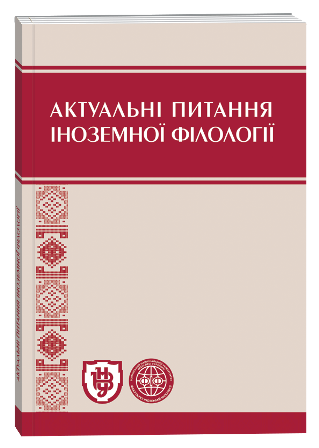ЛІНГВОРИТОРИЧНА СТРАТЕГІЧНА ІЄРАРХІЯ ПЕРЕКЛАДУ (НА МАТЕРІЯЛІ УКРАЇНСЬКИХ ТЛУМАЧЕНЬ ЗАГОЛОВКІВ АНГЛІЙСЬКОМОВНИХ ІНТЕРНЕТ-НОВИН)
DOI:
https://doi.org/10.32782/2410-0927-2022-16-3Ключові слова:
лінгвориторика, лінгвориторична стратегічна ієрархія перекладу, новинний заголовок, людські потреби, перекладацький хідАнотація
Мета розвідки – обґрунтувати доцільність поняття лінгвориторичної стратегічної ієрархії перекладу на матеріялі українських тлумачень англомовних заголовків. Задля цього залучено методологію риторичного аналізу з особливою увагою до канонів текстопобудови. У статті вперше визначено лінгвориторичну стратегічну ієрархію українського перекладу заголовків англомовних інтернет-новин як план впливу на читачів з опертям на риторичні канони: вибір теми перекладу на рівні інвенції з урахуванням базових потреб людини; розподіл змісту в позиціях привернення, утримування та спрямовування уваги на рівні диспозиції; використання низки перекладацьких ходів на рівні елокуції. Застосування запропонованої стратегічної ієрархії до аналізу перекладів на BBC News Україна англійськомовних новинних заголовків із сайту BBC News виявило, що на інвентивному рівні заголовки оригіналу й перекладу активують потреби в різній послідовності залежно від особливостей картини світу авдиторії, тоді як витлумачений заголовок може задіювати від двох до п’яти потреб, відповідно утворюючи кількакомпонентні послідовності. На диспозиційному рівні оригінальний і перекладений заголовки розподіляють зміст по позиціях привернення, утримування та спрямовування уваги. Позиція привернення уваги, розташована на початку заголовка, містить номінативні одиниці, що позначають найважливішу інформацію, звернену до потреб читачів. Позиція утримування уваги, співвідносна з присудком або групою присудка, характеризує сутність, названу в привертанні. Позиція спрямовування уваги закінчує заголовок, спонукаючи читачів до перегляду новинної статті. На елокутивному рівні номінативні одиниці оригінального заголовка, що апелюють до потреб читачів, відтворено в перекладі ходами еквівалентности, додавання, вилучення, зміни перспективації, категоризації та міжмовної метонімії. Хід еквівалентности точно відтворює в перекладі семантику одиниці оригіналу. Ходи додавання та вилучення референційного змісту відповідно доповнюють або випускають інформацію, адаптуючи її до картини світу читацької авдиторії. Хід зміни перспективації полягає в переміщенні одиниць із спрямовувальної позиції в оригіналі до привертальної в перекладі. Хід категоризації уможливлює зміну в перекладі семантики одиниць оригіналу між трьома рівнями: базовим, субординатним і суперординатним. Хід міжмовної метонімії замінює в перекладі номінативні засоби оригіналу на инші одиниці в аспекті суміжности або реального зв’язку, конкретизуючи інформацію для українського читача.
Посилання
Алексеева И. С. Введение в переводоведение. Учеб. пособие для студ. филол. и лингв. фак. высш. учеб. заведений. Москва : Академия, 2004. 352 с.
Аристотель. Поэтика. Риторика. СПб. : Азбука, 2015. 320 с.
Витренко Г. А. О «стратегии перевода». Вестник Московского государственного лингвистического университета. 2008. Вып. 536: Сопоставительная лингвистика и вопросы перевода. С. 3–17.
Дейк Т. А. ван. Язык. Познание. Коммуникация. Благовещенск : БГК им. И. А. Бодуэна де Куртенэ, 2000. 312 с.
Илюхин В. М. Стратегии в синхронном переводе: на материале англо-русских и русско-английских комбинаций перевода : дис. ... канд. филол. наук. М. : Моск. лингв. ун-т, 2000. 206 с.
Иссерс О. С. Коммуникативные стратегии и тактики русской речи. Москва : Издательство ЛКИ, 2012. 304 c.
Кафискина О. В. Стратегия перевода как термин переводоведения. Вестник Московского университета. Серия 22. 2017. № 1. С. 4–19.
Комиссаров В. Н. Теория перевода (лингвистические аспекты) : учеб. для ин-тов и фак. иностр. яз. Москва : Высш. шк., 1990. 253 с.
Панькова А. В. Використання локальних стратегій при перекладі історичних реалій. Молодий вчений. 2019. № 3 (1). С. 116–121. URL: http://nbuv.gov.ua/UJRN/molv_2019_3(1)__26 (дата звернення: 29.04.2022).
Подуфалова К. Стратегії перекладу для професійних цілей. Молодь і ринок. 2021. № 4/190. С. 153–156.
Потапенко С. І. Когнітивна риторика ефекту: в пошуках методу (на матеріалі інавгураційних звернень американських президентів Дж. Кеннеді і Дж. Буша). Вісник Київського національного лінгвістичного університету. 2012. № 2. С. 131–140.
Сдобников В. В. Стратегия перевода: общее определение. Вестник Иркутского государственного лингвистического университета. 2011. № 1. С. 165–172.
Спанатій Л. С. Риторика. Київ : Видавничий Дім «Ін Юре», 2008. 144 с.
Сумець О. М. Стратегічний менеджмент : підручник. Харків : ХНУВС, 2021. 208 с.
Betts R. Is strategy an illusion? International Security. 25 (2). 2004. Pp. 5–50. DOI: https://doi.org/10.1162/016228800560444
Cohen E. A. Strategy. Encyclopedia Britannica. 2007. URL: https://www.britannica.com/topic/strategy-military (дата звернення: 29.04.2022).
Hönig H. G. Strategie der Übersetzung : Ein Lehrund Arbeitsbuch. Tübingen : Narr, 1982. 205 S.
Iwama K. & Kano Y. Multiple News Headlines Generation using Page Metadata. ACLWeb: Association for Computational Linguistics, 2019. Pp. 101–105, DOI: https://doi.org/10.18653/v1/W19-8612
Kautz U. Handbuch Didaktik des Übersetzens und Dolmetschens. München : Iudicium, 2002. 643 S.
Lees-Marshment J., Conley B., Elder E., Pettitt R., Raynauld V., & Turcotte A. Political Marketing: Principles and Applications. London : Taylor & Francis, 2019. 266 p.
Maslow A. H. Motivation and Personality. N. Y. : Harper & Row Publishers, 1970. 368 p.
Mozuraityte R. Newspaper Style: Stylistic Features of the Headlines. Bachelor Thesis. Siauliai : Siauliai University, 2015. 39 p.
Perelman Ch., Olbrechts-Tyteca L. Die neue Rhetorik: Eine Abhandlung über das Argumentieren. Stuttgart-Bad Cannstatt : Fink, 2004. 570 S.
Potapenko S. Globalising and localising translation strategies from rhetorical perspective: Rendering English headlines into Ukrainian. SHS Web of Conferences. 105, 02001. 2021. DOI: https://doi.org/10.1051/shsconf/202110502001







